Medical expert of the article
New publications
Preparations
Ointments for pigment spots: on the skin of the face, body, hands, reviews
Last reviewed: 03.07.2025

All iLive content is medically reviewed or fact checked to ensure as much factual accuracy as possible.
We have strict sourcing guidelines and only link to reputable media sites, academic research institutions and, whenever possible, medically peer reviewed studies. Note that the numbers in parentheses ([1], [2], etc.) are clickable links to these studies.
If you feel that any of our content is inaccurate, out-of-date, or otherwise questionable, please select it and press Ctrl + Enter.

No matter how much we would like to have smooth, clear skin without moles and pigment spots, we can’t go against nature, so we often have to fight its ridiculous jokes with the help of special methods and means. One of the safest, albeit far from quickly effective means of getting rid of excess pigmentation is an ointment for pigment spots. Moreover, the whitening effect of various ointments can be greater or lesser, because not all products were developed specifically to reduce the intensity of pigment. For some creams, skin whitening is simply a side effect discovered by accident.
Indications of ointments for age spots
Probably, many have noticed that prolonged exposure to the sun provokes the appearance of dark spots on the skin, changes in the color of existing marks, increased pigmentation of freckles on the face and body, etc. You can fight such manifestations with the help of special sunscreens with a protective UV filter. But if the moment is missed and the appearance of pigment spots on the skin cannot be avoided, you can use various ointments for pigment spots with a whitening effect to return the skin to its former whiteness and tenderness.
But not only sun rays provoke an excess of the culprit of pigmentation melanin in the human body. Pigment spots can be congenital and acquired due to hormonal changes, age-related changes, metabolic disorders. In this regard, the indications for the use of ointments for pigment spots are quite wide:
- congenital pigment spots and moles
- areas of increased pigmentation caused by increased melatonin production (chloasma)
- dark, flat spots on the skin in middle-aged and older people that appear after exposure to the sun
- freckles on face and body
In addition, the ointment used for pigment spots is most often effective in the treatment of pimples, acne, acne and other skin defects.
Release form
In pursuit of beauty, we are often ready to spend any money to achieve the desired result, without even thinking that this money can be used more worthy, starting the fight against skin imperfections with inexpensive pharmacy products. But in most cases, things will not go further than that. Sometimes, however, homemade ointments come to the aid of pharmacy products. In any case, such care for the skin will give noticeable results at low cost.
And you can achieve the ideal only with the help of serious cosmetic procedures, for example, laser peeling. Even the most expensive and effective ointments and creams for pigment spots will not give such a result, but will only improve the appearance of the skin.
Names of ointments for pigment spots
So, why pay more if there are decent, inexpensive, but effective products. Take zinc ointment, for example. Zinc oxide in its composition has outstanding bleaching properties, which makes the ointment effective in terms of lightening pigment spots on the skin.
Zinc ointment is universal, so it can be successfully used as an ointment for pigment spots on the face. Here we get a double effect. Firstly, skin whitening. Secondly, the fight against pimples and acne due to the antimicrobial and mild drying effect. If the second problem is not relevant for you and the drying effect causes only discomfort, you can get rid of dryness and a feeling of tightness of the skin using moisturizing or oily creams.
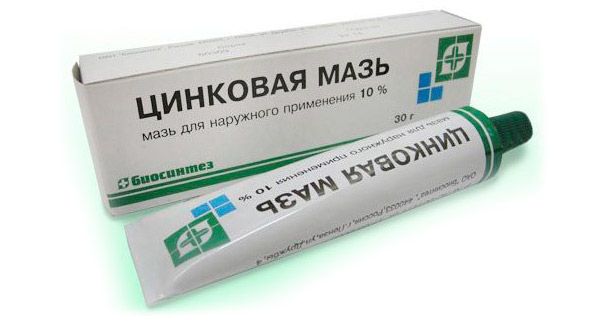
What is good about zinc ointment? According to many patients and doctors, it copes well with the task of lightening the pigment on the skin without causing harm to health. The only side effect of the ointment is allergic reactions, and even then they occur in isolated cases. And the only contraindication to the use of this drug is hypersensitivity to the active substance - zinc oxide, which is observed in a very small percentage of the population.
Zinc ointment for pigment spots can be used 2 to 6 times a day until the desired effect is achieved, applying it to cleansed skin with point movements. In the fight for skin beauty, the ointment will not spare pigment spots, acne and pimples, or fine wrinkles, which is also important.
The method of application and doses of the drug, which are negligible when applied topically, exclude the toxic effect of the ointment on the human body, which means that there is no talk of an overdose. However, zinc ointment should not be applied to areas of skin with open wounds and severe purulent inflammation.
Interaction with other drugs. Zinc ointment can be painlessly mixed with baby cream or castor oil. This will help to avoid overdrying of the skin.
Antifungal agents and the fight against pigment spots
Sulfur ointment is a fairly effective antifungal drug that, among other things, can combat acne and excessive pigmentation. The sulfur-based drug differs in its action from the previous one. Removal of pigment spots is achieved by drying and exfoliating the epidermal cells at the site of application of the ointment.
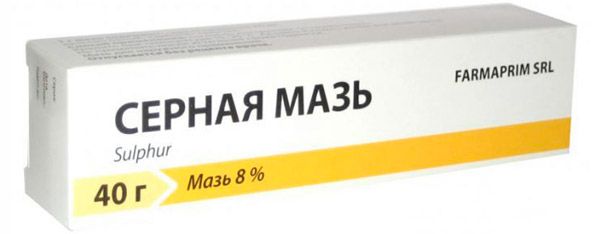
Sulfur-based preparations are not as safe as those with zinc oxide as the active ingredient, so it is advisable to use them no more than every other day, leaving them on the skin for 24 hours. The course of treatment with this scheme will be only 12 days.
Side effects of ointments for pigment spots are most often reduced to allergic reactions, and sulfur ointment is no exception. However, hypersensitivity to sulfur preparations is not the only contraindication to the use of sulfur ointment. It is also not recommended to use it to remove pigment spots in children under 3 years of age, although the ointment is allowed for use from 2 months of age.
The strong drying effect of sulfur ointment can have a negative effect on dry and sensitive skin, so if you use it as directed by your doctor, after removing the ointment from your skin, you should lubricate the pigmented areas with a moisturizer. You should not mix sulfur ointment with creams.
Interaction with other drugs. Before using sulfur ointment, it is not recommended to treat the skin with potassium permanganate or hydrogen peroxide, giving preference to other skin cleansing agents. Otherwise, you can get a severe burn on the skin.
A significant disadvantage of sulfur ointment is its unpleasant smell. In addition, it is difficult to wash off the skin, leaving yellowish greasy marks on clothing that comes into contact with the treated areas. Therefore, it is better to use it both on the face and on the body while at home.
Another antifungal drug that has proven itself in the fight against dark spots on the skin is Clotrimazole ointment. Noticeable effectiveness, a small number of contraindications and complications, and therefore relative safety, the absence of an unpleasant odor have made this product popular among those with freckles and other pigment spots.
To lighten areas with hyperpigmentation, apply the ointment to clean and dry skin 3 times a day: in the morning, during the day and before bed. Clotrimazole is well absorbed and leaves no marks on clothing. It is approved for use on the face, hands and body.
Clotrimazole ointment does not enter the bloodstream when applied externally, affecting only the superficial layers of the skin. Therefore, an overdose of the drug can be completely excluded. However, sometimes during the use of Clotrimazole unpleasant phenomena can be observed: burning, itching, which may indicate intolerance to the drug and require its cancellation.

It is not advisable to use this ointment in the area around the eyes, where the skin is most sensitive. Pregnancy and lactation are far from the best periods for removing pigment spots with Clotrimazole ointment.
Antibacterial agents and pigment spots
Not only antifungal agents can combat excessive pigmentation. Some antibacterial agents also have this ability. For example, syntomycin ointment based on chloramphenicol, although it belongs to the category of antibiotics, copes wonderfully not only with bacteria, but also with skin imperfections.
If someone is afraid that this ointment is an antibiotic that can be dangerous to health, there is no need to worry. The fact is that syntomycin ointment, like the previous ones, does not penetrate into the deep layers of the skin and tissues of the body, does not enter the blood, and therefore is relatively safe for humans.
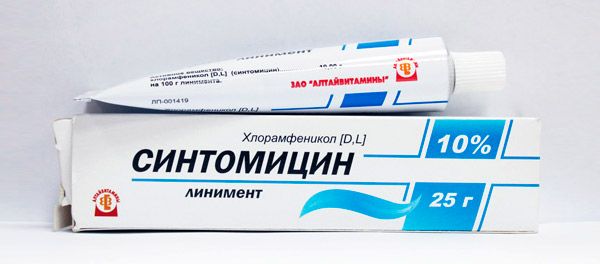
It is advisable to apply syntomycin ointment to the skin of the face and hands after cleaning and steaming. The skin should be dry. The duration of treatment is up to 1 month. In cases of longer use, addiction to the drug is observed. If 4 weeks are not enough to achieve the desired result, it makes sense to take a month-long break, and then continue treatment.
The ointment should be kept on the skin for at least 1 hour, applying pointwise to areas with increased pigmentation. It is possible that during this period there will be slight discomfort at the site of application. Usually, such a reaction is short-lived and passes within an hour. But sometimes an allergic reaction is more serious, and in this case, the drug should be discontinued.
Contraindications to the use of syntomycin ointment are hypersensitivity to the components of the drug and a toxic reaction to the active substance of the ointment in the anamnesis. Preparations based on levomycetin (chloramphenicol) are not prescribed for psoriasis, eczema, suppression of hematopoiesis, impaired renal and hepatic function, pregnancy, lactation. But given that external use of the ointment excludes its entry into the blood and other body fluids, the likelihood of complications is negligible. But it is still worth consulting a doctor about the possibility of using this ointment for pigment spots against the background of the above-described diseases.
The popular antiseptic salicylic ointment also has a good keratolytic and exfoliating effect. Salicylic acid in the ointment actively softens and removes the upper cells of the epidermis, which contain melanocytes responsible for the pigmentation of a certain area of the skin. This achieves skin lightening.
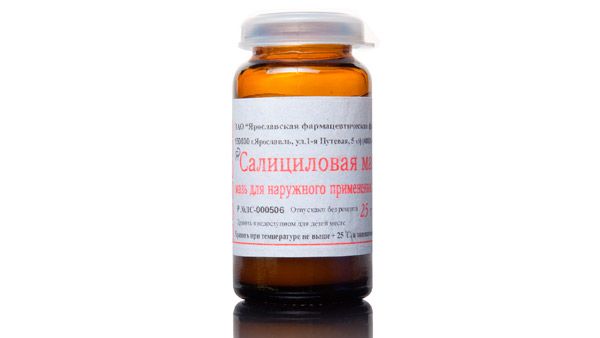
Salicylic ointment should be applied to the skin pointwise, avoiding areas of skin with normal pigmentation, no more than 2 g per application to avoid getting into the blood. This can be done up to 3 times a day. The therapeutic course should not exceed 4 weeks. An overdose of the drug causes severe allergic reactions.
Side effects of salicylic ointment for pigment spots are extremely rare. Usually, it is redness, itching and mild burning, corresponding to an allergic reaction to the drug.
Contraindications to the use of salicylic ointment are cases of hypersensitivity to the drug. Sometimes childhood is also indicated, so before using the ointment in children, it is recommended to consult a pediatrician. According to some sources, the ointment should not be applied to moles and birthmarks.
It cannot be said that salicylic ointment is dangerous to health, but it is a potent agent, so it is often used in multi-component ointments and masks, where it brings many benefits to those with unattractive dark spots. And yet, when using salicylic ointment together with other components, it is necessary to take into account the drug interaction with other drugs, since salicylic acid in the ointment can enhance the effect, including side effects of other drugs, and also form melting (with "Rizorcinol") and insoluble (with zinc oxide) compounds.
However, pharmacists managed to combine the incompatible, as a result of which a practically safe and effective whitening ointment appeared on the shelves of pharmacies - salicylic-zinc paste. Salicylic acid, as one of the components of the ointment, provides an exfoliating effect, and zinc oxide (the main active ingredient) has a whitening effect by reducing the production of melanocytes.
The product can be applied to the skin 2-3 times a day without fear of overdose, which is possible only when applying the ointment to large areas of skin. The ointment should not be applied to open wounds, especially festering ones, mucous membranes, or areas of skin that are constantly exposed to moisture (armpits, groin folds, etc.). The course of treatment can range from 7 to 20 days depending on the intensity of pigmentation.
Despite the apparent safety of the product, salicylic-zinc ointment has certain contraindications for use. The drug is not used to treat children, pregnant women and nursing mothers. Do not use the ointment in case of hypersensitivity to the components of the drug in order to avoid severe allergic reactions.
It is important to understand that salicylic-zinc ointment dries the skin no less than single-component preparations based on salicylic acid and zinc oxide, so its use on dry and sensitive skin is undesirable. However, baby cream and castor oil, which can be used during treatment with this ointment, will help to fix the problem.
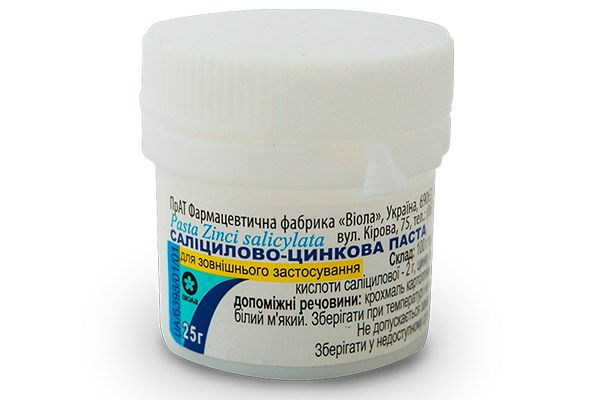
Drug interactions with other drugs. Salicylic-zinc ointment is not used during treatment with penicillin antibiotics, due to its ability to reduce the effectiveness of the latter. "Phenacetin" and "Rizorcin" can form mixtures with the ointment with an unpredictable effect, so the combination of these drugs is also undesirable.
 [ 3 ]
[ 3 ]
Vitamins and Excess Pigmentation
Retinoic ointment is currently a less popular remedy for pigment spots, despite all its beneficial properties. Perhaps this is due to the fact that the ointment is only available with a doctor's prescription, and our people do not suffer from a shortage of ointments that help with pigment spots. Be that as it may, retinoic ointment has a right to exist, including due to its skin-whitening properties.
Rejuvenating and anti-inflammatory retinoic ointment is nothing more than a synthetic analogue of vitamin A, hence the name. Its use implies caution, because an excess of vitamins is just as unsafe as a deficiency. Therefore, the use of the ointment is limited to 1-2 times a week. In this case, the ointment should be applied to the skin in a thin layer and only in the evening, since it increases the sensitivity of the skin to sunlight. When using the ointment during the day, the reaction can be exactly the opposite.

You should not use retinoic ointment for a long time. It is better to carry out treatment in short courses, interrupting it if discomfort occurs in the form of redness and peeling. After a couple of days, treatment with the drug can be resumed.
Retinoid-based ointment is not suitable for everyone. Children, pregnancy and lactation require prior consultation with a doctor regarding the possibility of using this ointment for pigment spots. Contraindications to the use of retinoic ointment may include hypersensitivity to the drug, liver and kidney failure, skin neoplasms, elevated levels of lipids and lipoproteins in the blood, excess vitamin A in the body.
Side effects of the ointment for pigment spots in the form of allergic reactions may appear either immediately or after 2-3 days. Other undesirable symptoms may be a consequence of hypervitaminosis of vitamin A. Such symptoms include dry mucous membranes and skin, development of conjunctivitis, pain in muscles and joints, headaches and cramps. More serious consequences are also possible, such as bleeding from the gastrointestinal tract, development of pancreatitis and inflammatory processes in the intestines.
Interaction with other drugs. Retinoic ointment is incompatible with aminoglycoside antibiotics and progesterone. Simultaneous use of ointment and vitamin A increases the risk of hypervitaminosis.
Pharmacy ointment for acne "Belosalik" and pigment spots
Ointment "Belosalik" is an anti-inflammatory agent with a pronounced keratolytic effect, due to which it has found application in the treatment of excessive pigmentation in adults and children over 6 months. The ointment is based on salicylic acid and betamethasone, which effectively cleanse the affected areas of the skin.
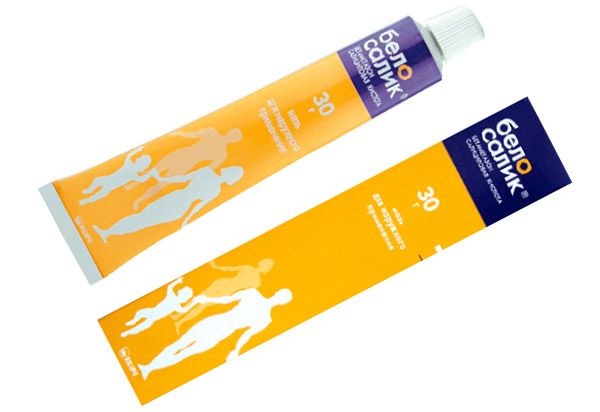
This ointment does not belong to the category of budget funds, moreover, unlike the ointments described above, it has many contraindications for use. These include chickenpox, tuberculosis of the skin, viral skin infections, and many other diseases that have their manifestations on the skin. The ointment is also not used on open wounds. And of course, the use of the ointment is prohibited if the patient has an intolerance to any of the components of the drug.
Method of administration and dosage. The drug should be applied 1-2 times a day to clean and dry skin, using a small amount of ointment. The duration of treatment with the drug should not exceed 4 weeks. If it is necessary to increase the therapeutic period, the drug should be applied to the skin once every 2 days to avoid an overdose of the drug.
Side effects of Belosalik ointment used for pigment spots are usually mild. These may be allergic reactions in the form of itching and redness, and sometimes more serious manifestations such as skin atrophy, inhibition of pigmentation, development of dermatitis, acne, and others. If the ointment is used for a long time, especially in the face area, betamethasone accumulates in the body and can provoke reactions associated with decreased functionality of the adrenal cortex.
Cosmetology in the fight for clear skin
Achromin ointment, also known as the whitening cream for pigment spots "Achromin" based on hydroquinone, belongs to the category of medicinal cosmetics, which can also be found on pharmacy shelves. This is one of the most popular ointments that combat the problem of dark spots on the skin and acne. Its effectiveness is actively discussed on forums, and most of the reviews are positive. By the way, according to the same reviews, the updated "Achromin" without hydroquinone is inferior in effectiveness to the original version.
"Achromin" has proven itself as a remedy for freckles and spots on the face and body, as well as an ointment for pigment spots on the hands, which often accompany the aging process of the body.
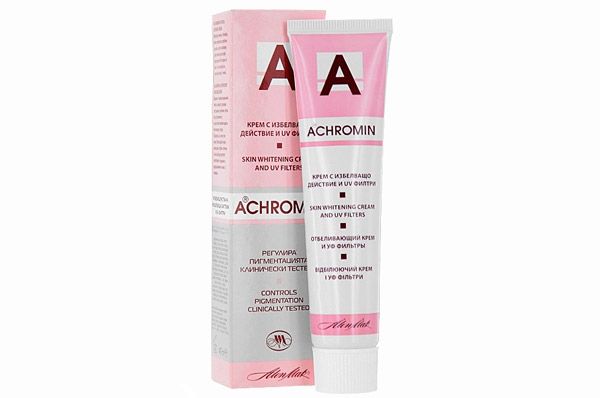
To lighten pigment spots, it is recommended to use the ointment twice a day: morning and evening, applying to clean skin with light massage movements. Usually the result becomes noticeable after 14-15 days, and after 1-3 months the pigment spots disappear completely.
Side effects of the ointment for pigment spots "Achromin" are observed very rarely in the form of skin irritation. In this case, it is recommended to let the skin calm down for 4-5 days, and then begin treatment again, applying the ointment once, in the evenings. After a week, if side effects do not occur, you can switch to the standard scheme of using the ointment.
Despite the effectiveness of "Achromin", this ointment for pigment spots is not intended for use by people under 12 years of age. The active substance of the ointment is to blame, which can be dangerous for a child's body. In large quantities, hydroquinone can also harm an adult body, so the ointment should not be used for more than a month. It is better to repeat the course of treatment after a while without risk to health.
Pharmacodynamics
The pharmacodynamics and pharmacokinetics of bleaching ointments used for pigment spots mainly depend on the main active ingredient of the drug, which can have an antioxidant, immunomodulatory, and membrane-protective effect on cells, i.e. prevents the destruction of the cell membrane.
Pharmacy creams used to combat increased pigmentation most often contain non-specific components such as vitamin A (or its synthetic analogue), zinc oxide, chloramphenicol (synthomycin), clotrimazole, salicylic acid, which have a sufficient whitening effect provided that ointments based on them are regularly used.
Products of various cosmetic companies may contain glycolic and azelaic acids, arbutin, rucinol, beta-carotene, hydroquinone and even mercury. Despite the noticeable effectiveness against pigment spots and a strong whitening effect, cosmetic ointments for pigment spots, due to some components that are unsafe for the body, can do more harm than good.
Therefore, before you start using them, you need to carefully study the composition of the creams and their effect on various systems and organs of the human body. For example, if arbutin and beta-carotene do not have a negative effect on the body, then mercury and hydroquinone are highly toxic substances and, if used incorrectly, can significantly undermine the patient's health.
The form of release of pharmaceutical and cosmetic products for pigment spots is ointments and creams for external use, most often sold in aluminum tubes or small glass (sometimes plastic) jars.
 [ 4 ]
[ 4 ]
Use of ointments for age spots during pregnancy
If in the case of a healthy adult we can say that all the above mentioned means are good for getting rid of unsightly spots on the skin, then pregnancy and breastfeeding impose certain restrictions on the use of medicines. After all, what good mother would put her interests above the health of her child? Here you will either have to be patient and love yourself as you are, or use unpopular means, but those ointments whose effect will be gentle on the baby's body.
The use of ointments for pigment spots during pregnancy should be preceded by a consultation not only with a dermatologist, but also with a gynecologist, who will help adjust the prescription of the previous specialist. For example, the same vaunted "Achromin" is not suitable for treating pigmentation during a delicate period, since hydroquinone, accumulating in the woman's body, can get to the baby through the placenta or breast milk. And this means that in this case it is safer to use another remedy.
Belosalik ointment can be used during pregnancy and lactation only according to strict indications. In this case, it is used on small areas of skin and for a very short time, avoiding the area of the mammary glands.
A woman can decide for herself whether to use syntomycin ointment during pregnancy and breastfeeding. The active substance of the ointment can penetrate the placenta and may enter breast milk, but no negative impact on the child was noted in all cases.
Retinoic ointment can cause an excess of vitamin A in the body, which will negatively affect the course of pregnancy and the development of the fetus.
Salicylic ointment is allowed for use during pregnancy, but it should be used for a short time and on small areas of skin.
Although Clotrimazole ointment for pigment spots is considered a generally safe remedy, it can still have a negative impact on fetal development in the first trimester of pregnancy. Starting from the 4th month of pregnancy, this ointment is used only under the supervision of a doctor. You should be careful when treating pigmentation with Clotrimazole during breastfeeding.
But ointments based on zinc oxide can be used in an "interesting" situation, since they do not have a harmful effect on either the mother or her baby. And yet, it always makes sense to first coordinate your decision with the opinion of a specialist doctor on this matter.
Storage conditions
Any ointment for pigment spots should be used before its expiration date, otherwise the result can take a very long time to appear. In addition, expired ointments can cause certain harm to the human body, like other drugs.
The shelf life of ointments for pigment spots can vary from 18 months to 5 years. The shortest shelf life is for akhromin ointment. But zinc ointment can retain its properties for 5 years if stored at a temperature of up to 15 degrees.
Salicylic-zinc ointment and Belosalik boast a long shelf life (4 years). At the same time, they can be stored at a higher temperature (up to 25 degrees).
Shelf life
The majority of ointments for pigment spots are stored for 2 years at a temperature not exceeding 20 degrees. Only retinoic ointment requires a lower storage temperature (from 2 to 8 degrees).
 [ 8 ]
[ 8 ]
In order for the ointment for pigment spots to retain its properties during the expiration date, it is necessary to observe the storage conditions indicated on the package. Ointments cannot be frozen, but exposure to sunlight and high temperatures also has a negative effect on them. It is best to store ointments in a dry, fairly cool, dark place, where access for children and our smaller brothers is limited.
Attention!
To simplify the perception of information, this instruction for use of the drug "Ointments for pigment spots: on the skin of the face, body, hands, reviews" translated and presented in a special form on the basis of the official instructions for medical use of the drug. Before use read the annotation that came directly to medicines.
Description provided for informational purposes and is not a guide to self-healing. The need for this drug, the purpose of the treatment regimen, methods and dose of the drug is determined solely by the attending physician. Self-medication is dangerous for your health.

